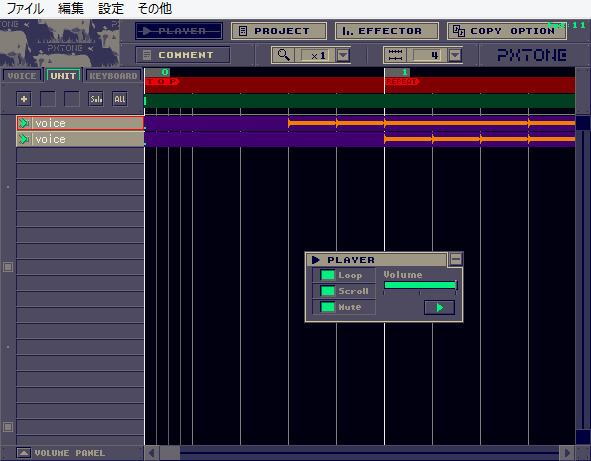Developer(s) Pixel of Studio Pixel Operating system | Stable release v.0.9.2.5 License Freeware | |
 | ||
Website studiopixel.sakura.ne.jp/pxtone/ | ||
PxTone Collage (ピストンコラージュ (Japanese)) is a freeware music editing program. The program is in development by Daisuke "Pixel" Amaya. It is currently in the beta stage of development.
Contents
The format is similar to MIDI files in many ways. A prominent difference includes instrument samples ("voices") that are stored within the song data itself.
The program also is capable of opening other sample formats developed by Pixel (ptnoise, ptvoice) as well as some more popular sample formats, such as .wav and .ogg. The primary interface of the program is a piano roll display used to place notes and specify duration, volume, panning, sample, and pitch. The tempo of a song can be set, but it cannot be changed during playback. The .pxtone format also allows the storage of some additional information, such as song comments and song name.
Along with Pxtone Collage are included several programs for creating instrument samples (ptnoise and ptvoice format) and a small player application. Included also are DLL and header files for programming with PxTone.
History
In 1998, Pixel released a small music-writing and playback application known as PiyoPiyo. This format features three melody tracks with customizable wave samples, and a fourth track dedicated solely to drum samples. The editor interface uses the piano roll that would become standard in all of Pixel's future music editors. A considerable flaw with the PiyoPiyo design is that its playback is linked to CPU usage, in that a heavily taxed CPU will cause playback to slow down.
Some time later, Pixel developed the Organya format for use in the indie game Cave Story. This format is very similar to PiyoPiyo, with the major difference being support for up to 8 melody tracks and 8 drum tracks for 16 simultaneous sounds. Rather than having the specifications of the waveform editable, Organya uses a built-in library of 100 wave "instruments" to choose from. Pxtone was developed as a successor to Organya.
